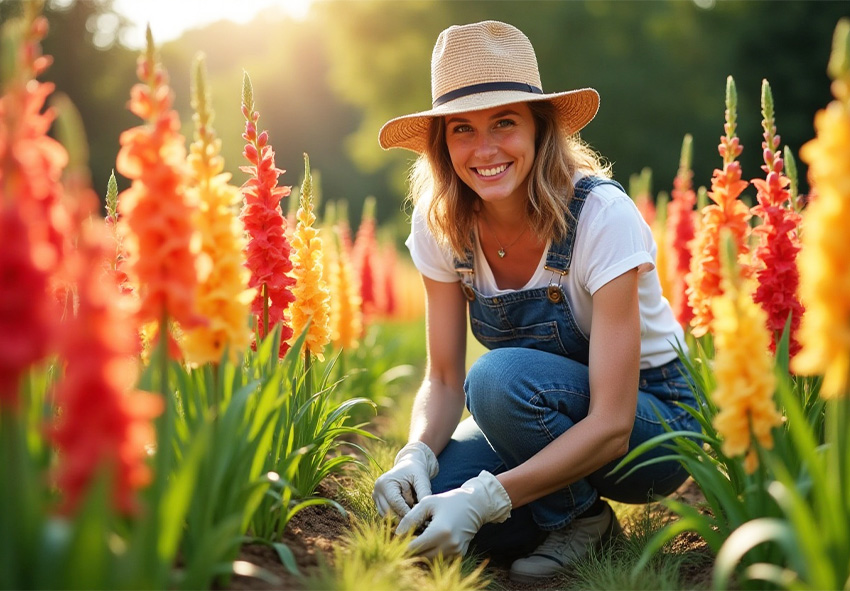Large flowering gladiolus are showstoppers in any garden, with their towering spikes of colorful blooms. Known for their grandeur, these flowers require specific care to thrive and deliver their stunning display. This guide will walk you through the best practices for growing and maintaining these remarkable plants. Our gardening blog is a perfect place to find all the information you need!
Choosing the Right Spot for Optimal Growth

Large flowering gladiolus need the right environment to reach their full potential. From light exposure to soil quality, choosing the proper location is the first step toward healthy plants and beautiful blooms.
Sunlight Requirements for large flowering gladiolus
Large flowering gladiolus prefer full sun, needing at least 6 hours of direct light daily. More sun means stronger stems and richer flower colors. Without adequate sunlight, plants may grow leggy and produce fewer blooms. For best results, avoid planting in areas with afternoon shade or dense tree cover.
Soil Type and Drainage
These flowers thrive in well-draining soil. Sandy or loamy soil enriched with compost is ideal to prevent root rot and promote corm development. Avoid heavy clay soil unless amended with organic matter. Poor drainage is one of the most common causes of failure in large flowering gladiolus cultivation.
Staggered Planting for Continuous Blooms
Rather than planting all at once, staggering your planting allows for an extended flowering period. This technique ensures a vibrant and ever-changing garden from early summer to fall.
How to Stagger Large Flowering Gladiolus Planting
Staggering your gladiolus planting is a simple yet highly effective technique to enjoy continuous blooms throughout the summer. Rather than planting all your corms at once, spreading out the planting schedule ensures that as one group finishes blooming, the next is just beginning. This approach not only extends the display period but also helps manage pests and unexpected weather events.
Staggered Planting Tips:
- Start Planting in Mid-Spring: Begin once the danger of frost has passed and soil temperatures reach about 55°F (13°C). This typically falls around mid to late spring, depending on your region.
- Use Varieties with Different Bloom Times: Combine early, mid, and late-season varieties to naturally extend the blooming window even further. This adds variety in color, height, and bloom duration.
- Label Each Planting Group: Use markers or tags to keep track of planting dates. This helps monitor bloom cycles and allows you to evaluate which timing worked best.
- Plan for Succession in Design: Design your beds with staggered bloom times in mind so that fading flowers are gradually replaced by fresh spikes, keeping your garden lively and colorful.
Best Timing and Depth for Planting Corms
Plant corms 4–6 inches deep and space them about 6 inches apart. The depth helps protect them from wind while encouraging strong root systems. Planting too shallow can lead to toppling, while too deep may delay emergence. Consistent spacing ensures adequate air circulation and easy maintenance.
Watering and Fertilization Tips
Consistent care during the growing season helps produce tall, healthy stalks and vibrant flowers. large flowering gladiolus aren’t high-maintenance, but they benefit from attention to watering and nutrients.
How Much Water Do Large Flowering Gladiolus Need?
Water deeply once or twice a week, especially in dry conditions. Avoid overwatering to prevent fungal diseases. Always water at the base to keep foliage dry and reduce disease risk. Use mulch to retain moisture and regulate soil temperature.
Fertilizer Choices and Application Schedule
Apply a balanced 10-10-10 fertilizer at planting, then again once the shoots appear and just before flowering. Avoid high-nitrogen blends that encourage leaves over blooms. Slow-release fertilizers can also be mixed into the soil for sustained feeding. Always water after applying to prevent root burn.
Supporting Tall Flower Spikes

Because large flowering gladiolus spikes can reach 3–5 feet tall, they often need support. Wind and rain can topple them without proper staking.
When and How to Stake Large Flowering Gladiolus
Large flowering gladiolus produce tall, elegant flower spikes that can reach up to 4 feet high. While stunning, these blooms can become top-heavy and are vulnerable to wind, rain, or even their own weight. Proper staking not only supports the stems but also keeps the plants upright and beautiful throughout the blooming season.
Tips for Staking Large Flowering Gladiolus:
- Stake Early, Before Flower Spikes Appear: Begin staking when the plants are about 12–18 inches tall, long before buds form. Early support helps the stems grow straight and reduces the risk of damaging roots later on.
- Use Sturdy Materials: Choose bamboo canes, wooden stakes, or metal rods that are tall and strong enough to support the mature plant height. Ensure they’re weather-resistant and won’t bend or break under weight.
- Place Stakes Close, but Not Too Close: Insert stakes about 2 inches away from the base of the plant to avoid piercing the corm or roots. Be gentle to prevent disturbing the plant’s growth.
- Tie Gently with Soft Materials: Use soft garden twine, cloth strips, or plant ties to loosely secure the stem to the stake. Avoid tight knots that can cut into the stems as they grow.
- Check and Adjust Regularly: As the gladiolus grows and blooms, check the ties weekly and adjust them if needed. This ensures continuous support and prevents stem bending or snapping.
Preventing Stem Damage from Weather
Plant in sheltered spots or near fences to reduce wind exposure. Mulch around the base to retain soil moisture and stabilize the plant. Avoid overcrowding, as tightly packed plants are more prone to tipping and fungal disease. Grouping large flowering gladiolus in clusters also offers mutual support.
Post-Bloom Care and Corm Maintenance
Once your large flowering gladiolus have bloomed, just like pest and diseases control for gladioli, postseason care is essential for future growth. This includes deadheading and properly storing corms.
Deadheading and Removing Spent Blooms
Remove flowers as they fade to prevent seed formation and encourage corm energy storage. Always leave the foliage intact until it yellows naturally. Deadheading also improves garden appearance and helps prevent pest attraction. Use clean, sharp scissors or pruners to reduce the risk of spreading disease.
How to Dig Up and Store Corms for Winter
After the first frost, dig up corms, remove soil, and cure them for a few days. Store in a cool, dry, ventilated area like a garage in paper bags or mesh. Before storage, discard any damaged or diseased corms. Label varieties to simplify planting decisions next season.
Tips for Healthier Blooms Year After Year

Keeping your large flowering gladiolus vibrant from one season to the next requires just a few smart practices. With proper care, your garden will be filled with strong, colorful spikes each year.
Why You Should Rotate Large Flowering Gladiolus Beds
Planting in the same spot each year increases disease risk. Rotating beds gives the soil time to recover and reduces pathogen buildup. It also balances soil nutrient levels. Use a 3-year rotation cycle if space allows.
Dividing and Replanting Cormlets
Cormlets, or small offsets that grow at the base of gladiolus corms, are an excellent way to propagate your favorite varieties. While they take a couple of seasons to reach full flowering size, dividing and replanting them is a cost-effective and rewarding method to expand your gladiolus display. Here’s how to properly divide and care for these baby bulbs.
Steps for Dividing and Replanting Cormlets:
- Wait Until After the First Frost: Allow the foliage to die back naturally after blooming. Once the first frost hits and the leaves turn brown, dig up the corms to access the cormlets attached underneath.
- Separate Cormlets Gently: Remove the dried outer layers of the main corm, and gently twist or snap off the smaller cormlets from the base. Use your hands rather than tools to avoid damaging them.
- Sort and Store the Cormlets: Select only firm, healthy cormlets for replanting. Store them in a dry, well-ventilated place over winter, such as in paper bags or mesh containers filled with peat moss.
- Plant in Spring in a Separate Bed: In spring, plant the cormlets about 2–3 inches deep and 2 inches apart in a nursery bed or dedicated area. This allows them space to grow and develop into mature corms.
- Be Patient and Provide Good Care: While most cormlets won’t bloom their first year, consistent watering, sunlight, and light fertilizing will encourage healthy growth. After 1–2 seasons, they’ll be large enough to produce blooms like the parent plant.
Conclusion
With the right care, large flowering gladiolus can transform your garden into a bold, colorful display. By choosing the right location, watering and feeding properly, supporting their tall stems, and managing pests and post-bloom maintenance, you’ll enjoy stunning blooms year after year. Ready to grow your own? Explore our collection of premium large flowering gladiolus corms in our online store and start planning your most beautiful flower bed yet.
Frequently Asked Questions (FAQs) about Large Flowering Gladiolus
1. When is the best time to plant large flowering gladiolus?
The ideal time to plant gladiolus is in spring, after the danger of frost has passed and the soil has warmed to around 55°F (13°C). You can also stagger plantings every 10–14 days through early summer to extend the blooming season and enjoy a continuous display of flowers.
2. How often should I water large flowering gladiolus?
Water gladiolus deeply once a week, ensuring the soil stays moist but not soggy. During dry spells or hot weather, increase watering frequency slightly. Consistent moisture is especially important during the bud and bloom stages to prevent wilting and ensure strong, vibrant flower spikes.
3. Do large flowering gladiolus need to be staked?
Yes, large flowering gladiolus often need staking due to their tall, heavy flower spikes. Use garden stakes or flower supports and tie the stems loosely with soft ties to prevent bending or snapping, especially in windy or rainy weather. Staking helps maintain an upright, tidy appearance in the garden.
4. Can I order Holland large flowering gladioli bulbs from your online store?
Yes, you can! Our online store Dutch-bulbs.com offers a wide selection of large flowering gladiolus plants, including different varieties and colors. We provide top-quality plants that are carefully cultivated and shipped with care to ensure they reach you in perfect condition.
5. How do I propagate large flowering gladiolus using cormlets?
Cormlets, or small bulbs that grow at the base of the main corm, can be saved and replanted in spring. Separate healthy cormlets, store them over winter, and plant them in a nursery bed. With proper care, most will bloom within one or two seasons, producing new gladiolus plants for your garden.
Published: 20.05.2025
